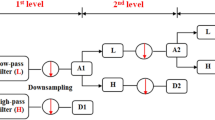Abstract
During the gear hobbing machine process, the hob performance degradation assessment is significant for optimizing the tool changing frequency and improving machining efficiency. It is challenging to recognize hob wear state through vibration analysis and signal processing. Especially in the condition of intense vibration and noise interference, extracting signal features that reflect the wear state is challenging work. This paper proposes a feature extraction method called Cyclic Statistical Energy (CSE) to obtain the hob wear characteristics by tracking the sensitive frequency band. For the method, the vibration signal model of hob spindle is established first based on the vibration-generation mechanism of the machining process. Then, an index E is proposed to track the wear resonance frequency band of the vibration signal. Furthermore, the cyclic statistical order is analyzed and discussed. The hob performance degradation assessment can be realized by analyzing the energy index E with time variation. The experimental setup has been designed, and the two tests have been conducted in the production line: (1) impact hammer test and (2) hob whole life cutting test. The impact hammer test is set to obtain the modal parameters of the hob. Based on this, the whole life cutting test is designed and realized by which the vibration data of whole life with different wear states can be acquired. The proposed method CSE is successfully applied into online industry experiments test. The results show that the proposed method can give a more accurate performance degradation assessment curve for tool condition monitoring compared with traditional methods such as Wavelet Packet Decomposition (WPD).























Similar content being viewed by others
References
Yu W, Tu W, Kim IY, Mechefske C (2021) A nonlinear-drift-driven Wiener process model for remaining useful life estimation considering three sources of variability. Reliab Eng Syst Saf 212:107631. https://doi.org/10.1016/j.ress.2021.107631
Cheng Y, Hu K, Wu J, Zhu H, Shao X (2022) Autoencoder Quasi-Recurrent neural networks for remaining useful life prediction of engineering systems. IEEEASME Trans Mechatron 27:1081–1092. https://doi.org/10.1109/TMECH.2021.3079729
Han Z, Ping Y, Pei J, Zhao Z, Luo Q (2020) Research and verification of vibration displacement and acceleration response model of hob spindle. J Mech Eng 56:72. https://doi.org/10.3901/JME.2020.07.072
Bukkapatnam STS, Kumara SRT, Lakhtakia A (2000) Fractal estimation of flank wear in turning. J Dyn Syst Meas Control 122:89–94. https://doi.org/10.1115/1.482446
Zhu K, Wong YS, Hong GS (2009) Wavelet analysis of sensor signals for tool condition monitoring: a review and some new results. Int J Mach Tools Manuf 49:537–553. https://doi.org/10.1016/j.ijmachtools.2009.02.003
Li N, Chen Y, Kong D, Tan S (2017) Force-based tool condition monitoring for turning process using v-support vector regression. Int J Adv Manuf Technol 91:351–361. https://doi.org/10.1007/s00170-016-9735-5
Zhu K, Liu T (2018) Online tool wear monitoring via Hidden Semi-Markov model with dependent durations. IEEE Trans Ind Inform 14:69–78. https://doi.org/10.1109/TII.2017.2723943
Zhou Y, Sun B, Sun W, Lei Z (2022) Tool wear condition monitoring based on a two-layer angle kernel extreme learning machine using sound sensor for milling process. J Intell Manuf 33:247–258. https://doi.org/10.1007/s10845-020-01663-1
Zhou Y, Zhi G, Chen W, Qian Q, He D, Sun B, Sun W (2022) A new tool wear condition monitoring method based on deep learning under small samples. Measurement 189:110622. https://doi.org/10.1016/j.measurement.2021.110622
Zhu Q, Sun B, Zhou Y, Sun W, Xiang J (2021) Sample augmentation for intelligent milling tool wear condition monitoring using numerical simulation and generative adversarial network. IEEE Trans Instrum Meas 70:1–10. https://doi.org/10.1109/TIM.2021.3077995
Albertelli P, Braghieri L, Torta M, Monno M (2019) Development of a generalized chatter detection methodology for variable speed machining. Mech Syst Signal Process 123:26–42. https://doi.org/10.1016/j.ymssp.2019.01.002
Sivasakthivel P, Sudhakaran R, Rajeswari S (2013) Optimization of machining parameters to minimize vibration amplitude while machining Al 6063 using gray-based Taguchi method. Proc Inst Mech Eng Part B J Eng Manuf 227:1788–1799. https://doi.org/10.1177/0954405413494921
Wang S, Yang Y, Zhou J, Li Q, Yang S, Kang L (2011) Effect of machining precision caused by NC gear hobbing deformation. Appl Mech Mater 86:692–695. https://doi.org/10.4028/www.scientific.net/AMM.86.692
Yu C, Huang X (2007) Analysis of calculating methods for hobbing force. Tool Eng 03:42–45. https://doi.org/10.16567/j.cnki.1000-7008.2007.03.012
Cong F, Chen J, Dong G, Pecht M (2013) Vibration model of rolling element bearings in a rotor-bearing system for fault diagnosis. J Sound Vib 332:2081–2097. https://doi.org/10.1016/j.jsv.2012.11.029
Goyal D, Vanraj PBS, Dhami SS (2017) Condition monitoring parameters for fault diagnosis of fixed axis gearbox: a review. Arch Comput Methods Eng 24:543–556. https://doi.org/10.1007/s11831-016-9176-1
Althubaiti A, Elasha F, Teixeira JA (2022) Fault diagnosis and health management of bearings in rotating equipment based on vibration analysis – a review. J Vibroeng 24:46–74. https://doi.org/10.21595/jve.2021.22100
Cho DW, Choi WC, Lee HY (2000) Detecting tool wear in face milling with different workpiece materials. Key Eng Mater 183–187:559–564. https://doi.org/10.4028/www.scientific.net/KEM.183-187.559
Acknowledgements
This research is supported by the National Key R&D Program of China (Grant No. 2019YFB1703700), ten thousand people plan project of Zhejiang Province, and the “Qizhen Program” of Zhejiang University.
Author information
Authors and Affiliations
Contributions
Feiyun Cong: conceptualization, supervision, writing—review and editing
Jiani Wu: writing and visualization
Li Chen: methodology, writing, data collection and analysis
Feng Lin: investigation and data curation
Faxiang Xie: resources and data curation
Corresponding author
Ethics declarations
Ethics approval
The work was original research that has not been published previously and is not under consideration for publication elsewhere, in whole or in part.
Consent to participate
Yes, consent to participate from all the authors.
Consent for publication
Yes, consent to publish from all the authors.
Conflict of interest
The authors declare no competing interests.
Additional information
Publisher's note
Springer Nature remains neutral with regard to jurisdictional claims in published maps and institutional affiliations.
Rights and permissions
Springer Nature or its licensor (e.g. a society or other partner) holds exclusive rights to this article under a publishing agreement with the author(s) or other rightsholder(s); author self-archiving of the accepted manuscript version of this article is solely governed by the terms of such publishing agreement and applicable law.
About this article
Cite this article
Cong, F., Wu, J., Chen, L. et al. Hob performance degradation assessment method based on cyclic statistical energy. Int J Adv Manuf Technol 125, 2103–2120 (2023). https://doi.org/10.1007/s00170-022-10635-z
Received:
Accepted:
Published:
Issue Date:
DOI: https://doi.org/10.1007/s00170-022-10635-z



